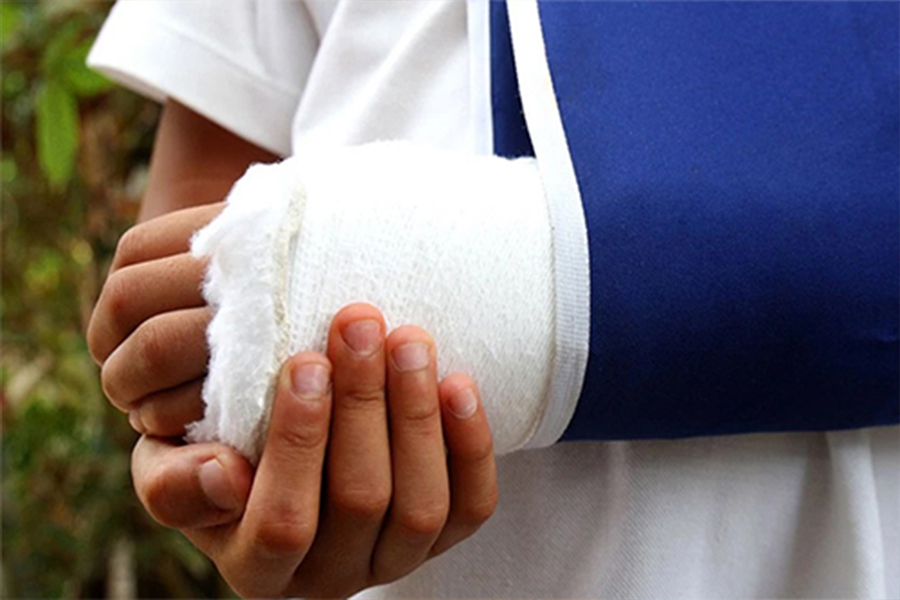As a parent, you want to be able to protect your child from getting hurt, but sometimes it feels impossible to avoid the bumps, bruises and broken bones.
If you suspect that you child might have a fracture but he or she is still moving the arm or leg normally and is not in much pain, a call to the pediatrician may be in order. Your child’s doctor may order an X-ray. If the X-ray shows a fracture, you will then be referred to an emergency department or orthopedic office for treatment.
If your child has an injury, is in significant pain and there is a deformity, it is important to go directly to the emergency department. With severe fractures, there is a chance of nerve damage or damage to blood vessels, so they need to be checked out right away.
“If you are concerned that your child has a broken bone, stabilize the arm or leg as best you can. It will make the car ride to the emergency department easier,” explains Kelly Levasseur, D.O., pediatric emergency physician at Beaumont Children’s. “If it’s necessary, call an ambulance and they can bring your child to the emergency department and will be able to give pain medication during the trip.”
At Beaumont, if a child comes in with a suspected broken bone, they are brought straight back to a room and are seen by a provider. If needed, pain medication is given quickly. Our goal is to keep children as comfortable as possible.
Check out our advice to care for a broken bone, so your child can heal quickly and get back to running, playing and having fun:
Expect some pain or soreness during the first few days.
You child could experience some pain or soreness during the first few days after a break. Your doctor might prescribe a pain reliever or recommend over-the-counter options to help.
Splint first, cast second.
A doctor might use a splint at first to wait for swelling to go down before putting a cast on a broken bone. Take care of the injury in the meantime by resting, elevating it while sleeping and icing as directed.
Pay attention to fingers and toes.
After your child has gotten a cast on, notice any reactions in their fingers and toes. Promptly contact a doctor if there is any change in color, numbness or swelling that occurs.
These reactions could be a sign of a cast that is too tight or an indication that the extremity is swelling a lot. Also, your child will want to wiggle their toes or fingers every so often to keep from getting stiff.
Combat an itchy cast with cool air.
Don’t try to scratch an itch by sticking a pen or ruler into a cast. Instead, use a hair dryer’s cool setting to blow cool air into the opening of the cast to relieve the itch.
Let a doctor make any adjustments.
Although it is tempting to mindlessly pick at the edge of a cast, ensure that your child is not picking at or removing any padding. Picking could result in jagged edges that can irritate the skin, and a doctor should make any adjustments to the padding.
Keep the cast or splint clean.
Your child will still want to play outside or spend a summer day at the beach, but emphasize the importance of keeping the cast or splint clean from dirt, sand, deodorants or lotions.
Only some casts can get wet.
Often, fiberglass casts can handle wetness, while plaster casts should be kept away from water. Leave a cast out of the tub and wrap the cast in plastic before a shower.
If the cast gets wet you should call your orthopedic physician to determine if you need to be seen and get a new cast. Your child might experience redness or raw skin from sweat or water that’s gotten the cast wet.
“If a splint is placed, it is important that it does not get wet or come off,” notes Dr. Levasseur. “If it gets wet, you may need to go to the orthopedist’s office or come back to the emergency department for a new one.”
Decorate away!
While your child waits for a broken bone to heal, doctors will usually give you the okay to decorate your cast. Encourage friends to sign it, create drawings or add stickers.
Taking care of a broken bone and the cast or splint is important and will help your child’s recovery stay on track.
Think ahead.
Thinking ahead is a key component to being prepared for any potential emergency situation. Think about which emergency room you would prefer for your family. Is it a dedicated pediatric emergency room with technology, specialists and programs just for kids? Is it important to you that if your child needs to be admitted he or she stay close to home at the hospital connected to the emergency room? In Oakland County, the only specialized pediatric emergency units attached to a hospital with children’s inpatient care are at Beaumont – in Royal Oak and in Troy.
Considering these important questions in advance of an emergency will help you remain calm and make the best possible decision for your child.
Trust your instincts.
Planning ahead and educating yourself will help you make good decisions when it comes to childhood emergencies. But, don’t underestimate the value of trusting your instincts either. If you feel your child needs to get to the emergency room, there’s a good chance you’re right. You know your child the best. You’re the best one to make that decision.


